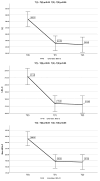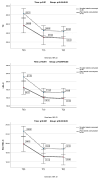Beneficial Effects of a Nutraceutical Combination on Lipid Profiles in Children with Moderate and Severe Hypercholesterolemia
- PMID: 39766315
- PMCID: PMC11674530
- DOI: 10.3390/biom14121608
Beneficial Effects of a Nutraceutical Combination on Lipid Profiles in Children with Moderate and Severe Hypercholesterolemia
Abstract
The aim of the present study was to evaluate the efficacy and safety of the long-term use of a dietary supplement containing red yeast rice (RYR), combined with other natural compounds, in children and adolescents with primary hypercholesterolemia. A nutraceutical, containing RYR, policosanols, coenzyme Q10, astaxanthin and folic acid (commercial name: Armolipid), was administered once daily in 84 children/adolescents with moderate or severe primary hypercholesterolemia. Moreover, 19 of the participants consumed 1.5-2.5 g of phytosterols daily until the initiation of dietary supplementation with Armolipid. Clinical and laboratory evaluation took place before and 6 and 16 months after treatment. Nutraceutical consumption resulted in a significant decrease in total cholesterol, low-density lipoprotein cholesterol, non-high-density lipoprotein cholesterol and apolipoprotein B levels, which was maintained with long-term administration (p < 0.001). No changes were observed in high-density lipoprotein cholesterol, triglycerides, apolipoprotein A1 and lipoprotein (a) levels. In children previously on phytosterol supplementation, Armolipid use exerted a further significant reduction in atherogenic lipoproteins. Armolipid may be an effective and safe complementary treatment for children with moderate and severe hypercholesterolemia. More prospective studies on larger cohorts are needed to establish the role of nutraceuticals containing RYR, policosanols and other natural compounds in the treatment of children with hypercholesterolemia.
Keywords: dyslipidemia; lipid profile; nutraceuticals; phytosterols; red yeast rice.
Conflict of interest statement
The authors have no conflicts of interest to declare.
Figures




Similar articles
-
Nutraceutical approach to moderate cardiometabolic risk: results of a randomized, double-blind and crossover study with Armolipid Plus.J Clin Lipidol. 2014 Jan-Feb;8(1):61-8. doi: 10.1016/j.jacl.2013.11.003. Epub 2013 Nov 11. J Clin Lipidol. 2014. PMID: 24528686 Clinical Trial.
-
Testing the Short-Term Efficacy of a Lipid-Lowering Nutraceutical in the Setting of Clinical Practice: A Multicenter Study.J Med Food. 2015 Nov;18(11):1270-3. doi: 10.1089/jmf.2015.0024. Epub 2015 Aug 14. J Med Food. 2015. PMID: 26274827 Free PMC article. Clinical Trial.
-
Long-term effects of nutraceuticals (berberine, red yeast rice, policosanol) in elderly hypercholesterolemic patients.Adv Ther. 2011 Dec;28(12):1105-13. doi: 10.1007/s12325-011-0082-5. Epub 2011 Nov 21. Adv Ther. 2011. PMID: 22113535 Clinical Trial.
-
Red Yeast Rice for Hypercholesterolemia: JACC Focus Seminar.J Am Coll Cardiol. 2021 Feb 9;77(5):620-628. doi: 10.1016/j.jacc.2020.11.056. J Am Coll Cardiol. 2021. PMID: 33538260 Review.
-
A nutraceutical approach (Armolipid Plus) to reduce total and LDL cholesterol in individuals with mild to moderate dyslipidemia: Review of the clinical evidence.Atheroscler Suppl. 2017 Feb;24:1-15. doi: 10.1016/j.atherosclerosissup.2016.10.003. Epub 2016 Dec 18. Atheroscler Suppl. 2017. PMID: 27998714 Review.
Cited by
-
The effects of terpenes on metabolism: a comprehensive review on recent updates.Curr Opin Clin Nutr Metab Care. 2025 Jul 1;28(4):323-329. doi: 10.1097/MCO.0000000000001129. Epub 2025 Apr 29. Curr Opin Clin Nutr Metab Care. 2025. PMID: 40296787 Free PMC article. Review.
References
-
- Watts G.F., Gidding S.S., Hegele R.A., Raal F.J., Sturm A.C., Jones L.K., Sarkies M.N., Al-Rasadi K., Blom D.J., Daccord M., et al. International Atherosclerosis Society guidance for implementing best practice in the care of familial hypercholesterolaemia. Nat. Rev. Cardiol. 2023;20:845–869. doi: 10.1038/s41569-023-00892-0. - DOI - PubMed
-
- Martino F., Barilla’ F., Martino E., Calcaterra G., Fanos V., Bassareo P.P. Familial Hypercholesterolaemia in Children and Adolescents: Current and Future Perspectives. Curr. Pediatr. Rev. 2023;19:234–241. - PubMed
-
- Ramaswami U., Futema M., Bogsrud M.P., Holven K.B., van Lennep J.R., Wiegman A., Descamps O.S., Vrablik M., Freiberger T., Dieplinger H., et al. Comparison of the characteristics at diagnosis and treatment of children with heterozygous familial hypercholesterolaemia (FH) from eight European countries. Atherosclerosis. 2019;292:178–187. doi: 10.1016/j.atherosclerosis.2019.11.012. - DOI - PMC - PubMed
MeSH terms
Substances
LinkOut - more resources
Full Text Sources
Medical

